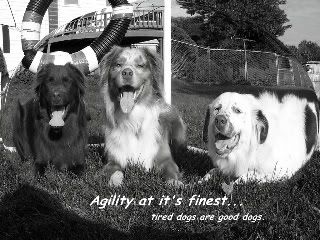Just a little more info on spaying/neutering to fill your heads
I think almost everyone here agrees that it's best to spay/neuter your pets, to prevent cancers and what not.
I recently heard about a study, though, in which the initial findings were that early spay/neuter can substantially increase the risk of osteosarcoma (bone cancer), *especially* in breeds prone to it. The study, done on Rotties, showed that males neutered prior to 7 months were 400% more likely to develop bone cancer in their lifetimes.)
The person I heard this from didn't have a link to the info, but did have a copy of the abstract which I'll post here:
Influence of Gender and timing of Gonadectomy on risk for appendicular bone sarcoma in Rottweilers
Cooley DM, Beranek B, Glickman LT, Waters DJ.
Departments of Veterinary Clinical Sciences and Veterinary Pathobiology Purdue University, West Lafayette, IN 47907
Background: The role of sex hormones in bone sarcomagenesis has not been extensively studied. In a previous study using the Veterinary Medical Database (VMDB), Ru et al. (Vet J 1998:156 ??-39) found a significantly increased risk for osteosarcoma in castrated males and spayed females compared with sexually intact dogs. However, this VMDB-based study could not evaluate whether age at neutering significantly influenced osteosarcoma risk. Purpose: To determine if gender or lifetime duration of gonadal exposure influences the risk for appendicular bone sarcoma in Rottweilers. Methods: Data were obtained from owners of 746
purebred Rottweilers as part of a nationwide, population based study. Each dog owner completed a questionnaire regarding gender neuter status, age at spay or castration, bone tumor occurence, age at diagnosis, current vital status and age of death. The incidence of appendicular bone sarcoma per 1000 dog years at risk was determined for intact males, castrated males, intact females, and spayed females. The relative risk (RR) and 95% confidence limit of appendicular bone sarcoma
was calculated by dividing the incidence rate for each gender-neuter category by the incidence rate for intact males (reference category; rr=1.0). For males and females, the influence of lifetime exposure to gonadal hormones on bone sarcoma was determined by comparison of the incidence of four subgroups stratified by age at neutering. Results: Appendicular bone sarcoma affected 111 of 746 (14.9%) Rottweilers. The RR for bone sarcoma was 1.64 for castrated males, 1.36 for spayed females and 1.04 for intact females. Females spayed at <1 year of age had a significantly increased risk for appendicular bone sarcoma compared with intact
females (RR=2.21). Similarly, males castrated at <1 year of age had a significantly increased risk for bone sarcoma compared with intact males (RR=3.12%) Conclusions: In this population-based study, Rottweilers that underwent gonadectomy at <1 year of age had a significantly increased risk for bone sarcoma. These observations may be explained by either a direct effect of sex hormones on skeletal homeostasis or by indirect effects on body conformation or physical activity.
Alternately, confounding factors unique to dogs that undergo early spay or castration may account for this association.
And also here's a link to an article on the etiology (cause) of different canine cancers. http://ravenwooddals.tripod.com/cancer.htm
Here's the section on osteosarcoma:
VI. Osteosarcoma
Bone tumors in dogs are very similar to those in humans. The small region between the shaft and ends of the long bones (the metaphysis, where growth occurs) is the most common site. These tumors are usually high-grade, aggressive, and usually spread to other parts of the body. The lung is most commonly involved.
Osteosarcoma tends to affect larger breeds with a slight increase in incidence with age. Males are more likely to be affected than are females. And since neutered dogs and bitches have twice the risk of developing the disease as compared to intact dogs, hormonal factors are thought to play a role.
Weight-bearing long bones of the legs are most frequently involved, especially the metaphysis of the radius. Breeds which weigh over 80 pounds are 61 times more likely to develop bone cancer than dogs weighing less than this amount. Also, the rates of developing bone cancer between breeds increases with standard height of the breed independent of the dogs' weight. This means, for example, that when you consider two breeds which weigh over 80 pounds, say an Irish Wolfhound and a mastiff, the wolfhound has a higher likelihood of getting osteosarcoma because he is taller at the withers. However, within a given breed, heavier animals are more likely to develop the disease.
As in human children, development of bone cancer in dogs is related to rapid bone growth. It is postulated that strenuous activity causing microscopic fractures of bones during periods of rapid growth induces cancer formation. Since taller dogs have a longer growth period than smaller ones, they are exposed to the risk of getting the cancer for a longer period of time. Likewise, heavier dogs are more likely to stress their developing bones leading to the microscopic fractures that start the tumor development process.
Ionizing radiation (as is given in radiation therapy) and having a metallic implant in the repair of a fracture are both associated with developing osteosarcoma. However, given their rarity in dogs, neither of these two factors is likely responsible for a significant number of bone tumors.
Anyways, interesting reading to say the least.








 Reply With Quote
Reply With Quote






Bookmarks